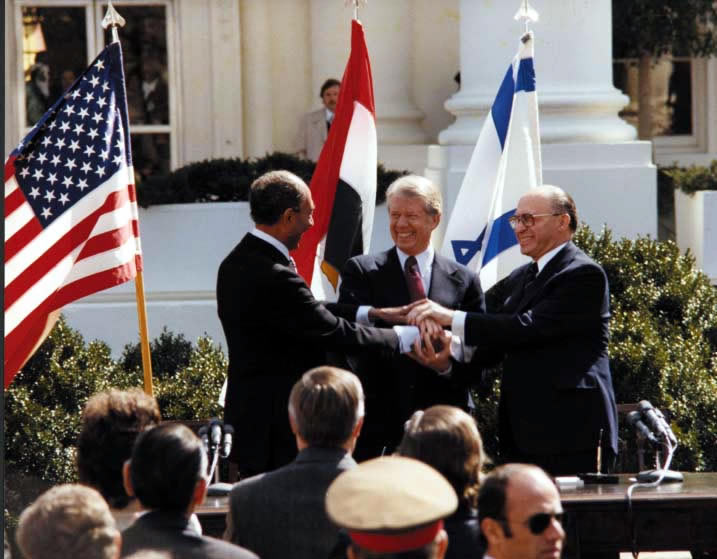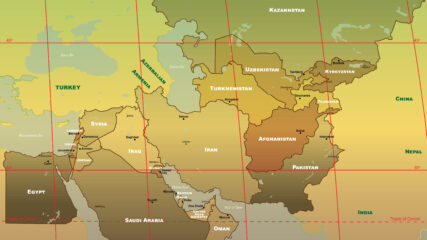March 26, 2025
By Ken Stein
The ripe conditions that prefaced the 1979 Egyptian-Israeli treaty and might presage additional Arab-Israeli agreements are almost totally absent in 2025. Why? Today, there is an absence of political will, courage and foresight of leaders to change the nonwar status quo; dysfunctional structural weaknesses are present among all parties to the conflict, especially Lebanon, Syria, Iraq and the PA/PLO; massive political instability exists on all of Israel’s borders for states and insurgencies to prioritize their own existence; none of the sides to the conflict is willing to recognize unequivocally the sovereignty, territorial integrity and legitimacy of the other; the level and frequency of hatred aimed at Israel from many Arab and Muslim leaders has been joined by unprecedented vitriol directed against Israel’s existence almost daily in Arabic, Turkish and Persian newspapers, on social media, and from the mosque podium. Unlike 1979, virtually unlimited resources from petro-dollar wealth could prevent or undo any and all agreements that might be attempted or reached. The irrevocable reality exists, as Ambassador Sam Lewis said: “Outside parties or mediators to a conflict cannot want the conflict resolved more than the parties to the conflict do themselves.”
Sadat: The Engine That Drove Egyptian-Israeli Negotiations
The Egyptian-Israeli peace treaty was the fourth Arab-Israeli agreement signed after the 1973 October war, with another not signed until the 1993 Oslo Accords. Egyptian President Anwar Sadat and Israeli Prime Minister Menachem Begin met their respective national interests in signing this bilateral treaty, confounding the Carter administration’s preferred comprehensive peace between Israel and all of her proximate neighbors. Sadat’s relentless pursuit of the full return of Israeli-held Egyptian Sinai and securing Israel’s commitment to evacuate all of Israeli settlements there were major Egyptian diplomatic successes.
Sadat calculated correctly that the PLO leadership remained adamant in its refusal to negotiate and recognize Israel and that Israel had no intention to see a Palestinian state emerge in the West Bank and Gaza Strip. Indeed, Sadat made a separate peace with Israel because no other Arab party was prepared to join his unprecedented initiative to recognize the Jewish state. Sadat proved to be at least a decade ahead of his Arab peers in realizing that the expenditure of human lives and national treasure to try to destroy Israel was not sustainable, especially while the United States heavily sided with Israel.
After coming to office in 1970, according to his close adviser Tahsin Bashir, Sadat became the driving force to obtain the return of Sinai to Egyptian sovereignty. Regaining Sinai was part of Sadat’s broader reorientation of Egypt: He sought to distance Cairo from Moscow’s influence, redirect the Egyptian economy toward capitalism, and harness the attention of Henry Kissinger and the friendship of Jimmy Carter to gain American economic and military assistance.
Sadat was fully aware that his outreach to Israel would alienate him and Egypt from the rest of the Arab and Muslim worlds. He never wavered from the view that a Western reorientation would be in Egypt’s best interest. For that decision, Sadat was assassinated October 6, 1981.
For a decade after the treaty was signed, the vast majority of Muslim and Arab states venomously opposed Egypt’s recognition of Israel. With the treaty in hand, Israel secured a major strategic success by removing as an enemy the largest Arab and Muslim state, which had been in open confrontation with Israel since 1948. To obtain a treaty with Egypt, Israel did not have to pay the heavy price sought by the Carter administration: a commitment to withdraw from the West Bank and Gaza Strip, the devolution of an independent Palestinian state, and a halting of Israeli settlements in those areas. Instead, Israel could focus on solidifying its security position in relation to Lebanon, the Golan Heights, the Gaza Strip, the West Bank, Jerusalem and Jordan.
Carter’s foreign policy success in the Egyptian-Israeli negotiations did not lead to broader Arab-Israeli agreements or boost his support in his 1980 re-election bid. Any improvement in U.S. public from his unprecedented diplomatic success was more than cancelled by the struggling economy, the high price of oil, and his image as being soft if not inept in other international regions, from the Soviet invasion of Afghanistan to the loss of longtime ally Iran with the fall of the Shah and the holding of American hostages for his last year in office. As a sitting president, he faced a tough challenge to his renomination from Sen. Ted Kennedy of Massachusetts, which shook the Democratic Party for months before the August 1980 national convention.
Besides those crucial variables, Carter by 1980 had publicly evoked, often with righteous candor, mixed messages about the U.S. relationship with Israel. He said he would stand by Israel’s security needs, which he did, but he was the only U.S. president who supported or abstained on four U.N. resolutions that condemned Israel’s presence in the territories secured in June 1967.
His most vocal cheerleader in stinging Israel was National Security Adviser Zbigniew Brzezinski, who answered my question about why American Jews did not trust him: “What do you think, Ken? I am both Polish and Catholic.” But he coached Carter to be harsh and critical toward Israel for reasons beyond his personal background: Brzezinski sought to break the back of Israeli influence in Washington, especially that of AIPAC, the American Israel Public Affairs Committee.
After the March 1979 treaty signing, Carter maintained sharp criticism of Begin for building or planning settlements in the territories and claimed that Begin worked to defeat his re-election in 1980. All evidence available today suggests that while Israeli Defense Minister Ezer Weizman endorsed Carter’s re-election in 1980, Begin told anyone who would listen that a second Carter term would not be in Israel’s interest, according to Samuel Lewis, the U.S. ambassador to Israel at the time.
As for the treaty itself, Egypt and Israel signed it 16 months after Sadat visited Jerusalem. More than any other political leader, Sadat kept the diplomatic car running with his foot on the accelerator, providing gas even in neutral and shifting gears and giving gas when it was necessary. When Sadat recognized the PLO as the sole legitimate representative of the Palestinian people in several Arab summit meetings in 1974 and 1975, he understood and promoted two separate motivations: genuine support for Palestinian political aspirations led by the PLO and recognition that if he supported the PLO vocally, Israelis by necessity would look toward Egypt and Sinai. Sadat knew that all Israeli leaders would reject any genuine negotiations on the future of the West Bank, the Gaza Strip and Jerusalem because that would mean talking with the hated PLO. Sadat also knew from 1974 forward that Syrian President Hafez al-Assad was completely opposed to any negotiations with Israel and that Jordan remained too timid to enter into separate negotiations with Israel, particularly because the Israelis were not in a sharing mood about the future of Jerusalem.
The final contents of the Egyptian-Israel treaty showed that Sadat made extraordinary compromises from his initial demands for full Israeli withdrawal from all the territories and the promotion of Palestinian political rights. The treaty contains nine articles, a military annex, an annex dealing with the relations between the parties, agreed understandings interpreting the main articles of the treaty, and side letters signed by both sides that interpret key phrases and concepts mentioned in the treaty. The treaty’s foundation included U.N. Security Council Resolutions 242 and 338, which called for the exchange of land for peace, direct negotiations between the parties, and territorial integrity for all states in the area. The treaty ended the state of war between Cairo and Jerusalem, established permanent borders, noted both parties’ commitments to refrain from acts or threats of violence between them, and called for an exchange of ambassadors. It affirmed Israel’s right to freedom of navigation through the international waters in the Middle East (Straits of Tiran and Gulf of Aqaba); Egypt’s effort to block such navigation was a major causes of the June 1967 war.
Critical for Israel was the inclusion of Article 6, which essentially said Egypt had an obligation to observe its treaty with Israel over all other treaties Egypt had or would have with other states. In other words, Egypt would not come to the aid of an Arab state at war with Israel.
In a separate Memorandum of Agreement concluded the same day as the treaty, the U.S. spelled out its commitments to Israel, including a promise to sell Israel oil should it not be able to obtain a supply from Egypt, as promised in the treaty. Israel paid a heavy price for peace with Egypt, returning land and oil fields and withdrawing settlements from Sinai. But in return it removed the most militarily powerful Arab state as a threat. Both Sadat and Begin made critical trade-offs with the United States, essentially guaranteeing the political outcomes.
Lessons Learned and Long-Term Impact From the Negotiations
- As fierce nationalists, Begin and Sadat zealously defended their prerogatives not to have any other entity or state, including the United States, dictate to them the content or pace of political negotiations and what they deemed their national security requirements. Both carefully listened to the Carter administration, but they retained to themselves exclusive determination of what those national priorities were or would be.
- Both represented mature states, not dysfunctional states or organizations, and each accepted the sovereign legitimacy of the other. This is not the case in 2025. Neither a majority of Palestinians nor Israelis, let along their leaders, fully and unequivocally accept the sovereignty, legitimacy or territorial integrity of the other.
- Reaching an agreement with the other enhanced respective national interests. Israel could not reject a once-in-a-generation opportunity to secure diplomatic recognition through a peace treaty with the most populous and militarily powerful Arab state and what was considered the most salient Arab state culturally and intellectually. At the end of the day, Sadat could not allow his path-breaking November 1977 visit to Jerusalem to go unrewarded without the full return of Israeli-held Sinai, the removal of Israel’s Sinai settlements and a deepened relationship with the United States. He achieved those objectives, as did his successors for the subsequent 45 years.
- Egyptian and Israeli leaders made core political trade-offs. Egypt “violated” a 1967 Arab commitment for “no peace, no negotiation and no recognition of Israel.” Begin uprooted settlements despite enormous domestic criticism from his lifelong political allies.
- Egypt set a diplomatic precedent for some Arab states. Each could and did reach treaties with Israel based on promoting national self-interests — Jordan in a bilateral peace treaty in 1994; UAE, Bahrain, Morocco and Sudan in the Abraham Accords in 2020 — and still publicly advocate for the Palestinians, but not with the emotional zest those states exhibited through the 1970s. The states that recognized Israel after 1979 chose not to prioritize the Palestinian quest for a state, or more specifically the elimination of Israel, over particular national interests.
- Egypt and Israel pulled closer to the United States, despite little progress made in resolving the issue of Palestinian rights. The other Arab states that pulled closer to Israel similarly received political, economic or military rewards from the United States.
- Israel focused on securing its other borders and on managing internal requirements — economy, new immigrants, matters of religion and identity. But as the Hamas attacks on Israel in October 2023 showed, as the subsequent conflict with Hezbollah from Lebanon demonstrated, and as the two Iranian attacks on Israel in 2024 revealed beyond any doubt, Israel’s borders and population are not remotely fully secure. Israel’s neighbors are far more publicly hateful of the Jewish state and Jews than articulated in 1979.
- Forty years later, no new major Arab-Israeli war had occurred.
- A major presidential foreign policy success did not automatically translate into domestic political support and votes, as Carter found out in the 1980 presidential election.
The Egyptian-Israeli treaty did not reduce the hatred of some Muslims and Arabs toward Israel. That hatred spewed forth from the Iranian Islamic Republic beginning in 1979 and expanded throughout the Arab and Muslim worlds, in constant competition with the many Middle Easterners prepared to come to grips with Israel’s permanence.
Thus, the treaty was another transaction of exchanging land for peace, the diplomatic concept that emerged out the June 1967 war, as stated: “Under what conditions and over what period of time would or should Israel return territories secured in the June war, AND, what guarantees would Israel receive in return for relinquishing lands.” The land-for-peace formula was not applied by Israel to any other neighboring country nor to the PLO. The 1979 precedent was not implemented again.
The treaty did not transform political attitudes across the Middle East about Israel. Iran, Hamas, Hezbollah and Syria remained adamant in refusing to recognize Israel. The core principles of these entities remained uncompromising in rejecting a Jewish state in the region. In 2025, Lebanon, Iraq and the PA/PLO remained politically fractured, their economies in dire stress as they reeled from seemingly unsolvable leadership or governing crises.
The Egyptian-Israeli treaty and the six years of negotiations that preceded it took place in a Middle Eastern setting that was stable and not rocked by fervent Islamic ideology nor an abundance of oil wealth that could sustain vehement antagonism against Israel and against any countries that accepted Israel’s reality. In 2025, the region and especially the countries on Israel’s borders are characterized by political uncertainty, sectarianism, demographic overload, economic weaknesses and insurgencies that mitigate against reaching state-to-state accommodations. The tranquility and stability of states that existed in the Middle East of the 1970s are gone in 2025.
Conditions of partial peace and full hostilities between Israel and her neighbors exist side by side in 2025. Not only is hostility toward Israel evident from Arab and Muslim leaders, but it also remains rampant and repeated almost daily in Arabic, Turkish, and Persian writings in newspapers, on social media, and from the mosque podium.
Israel’s Sinai withdrawal worked to sustain the Egyptian-Israeli peace. But subsequent Israeli withdrawals from Lebanon in 2000 and from the Gaza Strip in 2005 brought vengeful hostility to two critical border regions.
Today, the Israeli domestic political setting is wracked by bitter internal disputes on a range of issues, not the least of which remains the absence of any consensus on what treaty or partial agreement could be implemented with the Palestinians living west of the Jordan River.
Despite the persistent urging by parties, pundits and governments wishing to end the conflict, it cannot happen unless the respective sides to the conflict are prepared to embrace the “day after” and can be reasonably assured that agreements will remain in force even if monitored and guaranteed by external promises.
There is an irrevocable reality, wisely pronounced by Samuel W. Lewis, the U.S. ambassador to Israel from 1977 to 1985: “Outside parties or mediators to a conflict cannot want the conflict resolved more than the parties to the conflict do themselves.”









